Tailfin Long Top Tube Bag review: Do you want to supersize that?
Just like a top tube bag but longer, this is a stable, robust solution for riders longing to stash and retrieve heaps of gear on the go
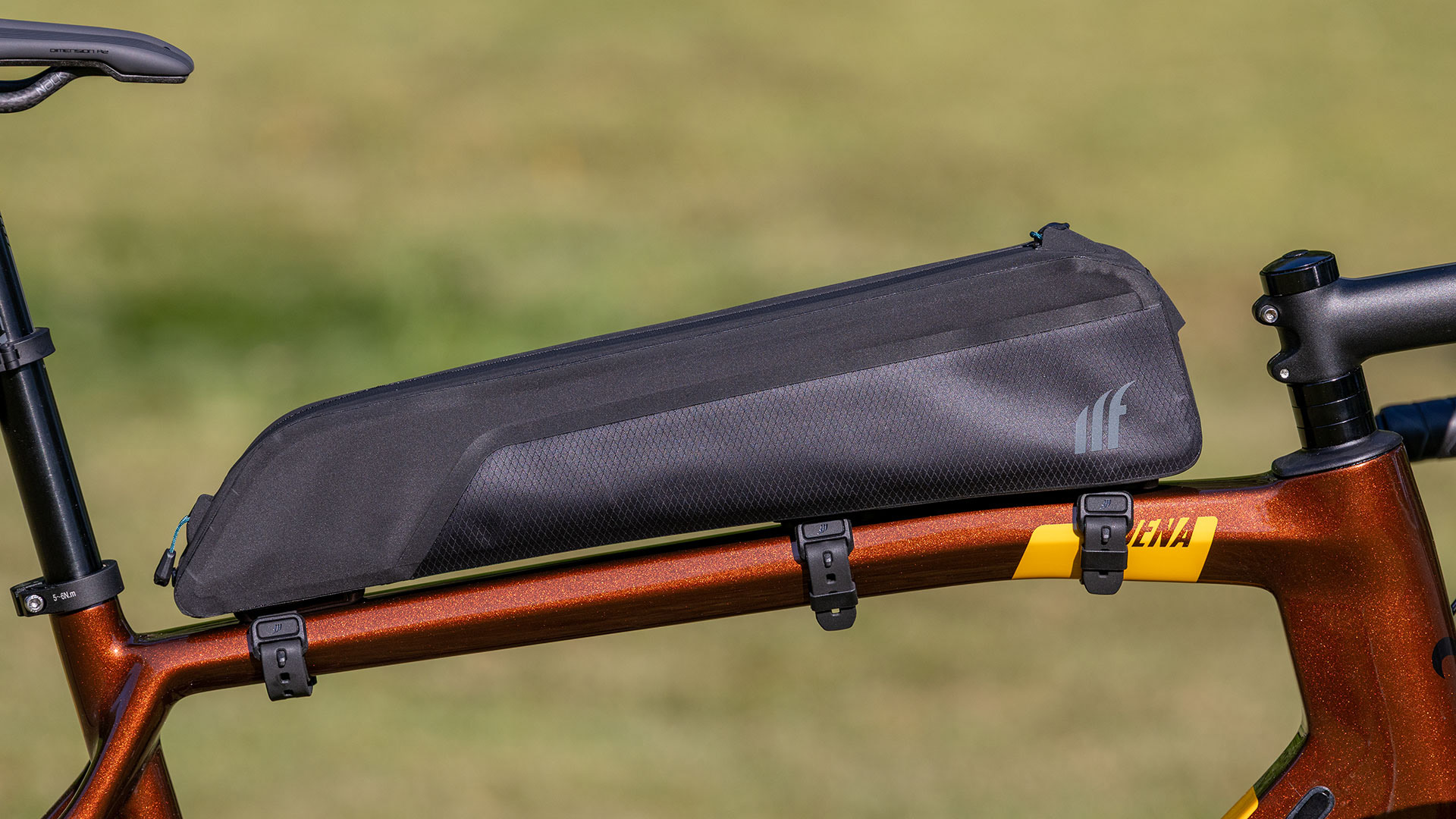
If you must buy a long top tube bag, this is one of the best on the market. The V-mount attachment system is second to none, and the bag is both durable and robustly weather-resistant. Like all Tailfin products, it’s an investment, but then quality costs.
-
+
Rock solid V-mount attachment system
-
+
Durable and weatherproof
-
+
Structural integrity is impressive, with next to no movement or swap
-
-
More expensive than the competition
-
-
Rigid sides make it harder to pry the bag open.
-
-
The much-needed accessory pack is an additional expense.
You can trust Cycling Weekly.

It's been seven years since Tailfin launched its iconic AeroPack rack ’n pack system. During this time, it has developed an abundance of additional storage options that rival even the best bikepacking bags. Panniers, fork bags, frame bags, downtube bags, bar bags, and top tube bags – there's now enough product available from the Bristol brand to smother a bike entirely for any amount of bike packing.
None of these products has been quite as revolutionary as the original Tailfin AeroPack. Still, all are masterclasses in building dependable on-bike storage that also happens to look pretty cool. Such devotion to product excellence has garnered Tailfin a loyal following, and deservedly so.
Its Long Top Tube Bag, launched at the tail end of 2024, is an intriguing concept because most of us, I'm sure, consider a top tube bag to be a small bento box affair from which to grab a few snacks and other essentials during a ride.
Does anyone really need a 'long' top tube bag? Wouldn't a frame bag be a more suitable place to stow such a volume of gear? Do you need both?
Well, Tailfin hasn't invented an entirely new type of product; similar, lengthy bags from brands like Restrap, Apidura, and others already exist. I'll discuss who should consider one, and why, shortly.
Construction
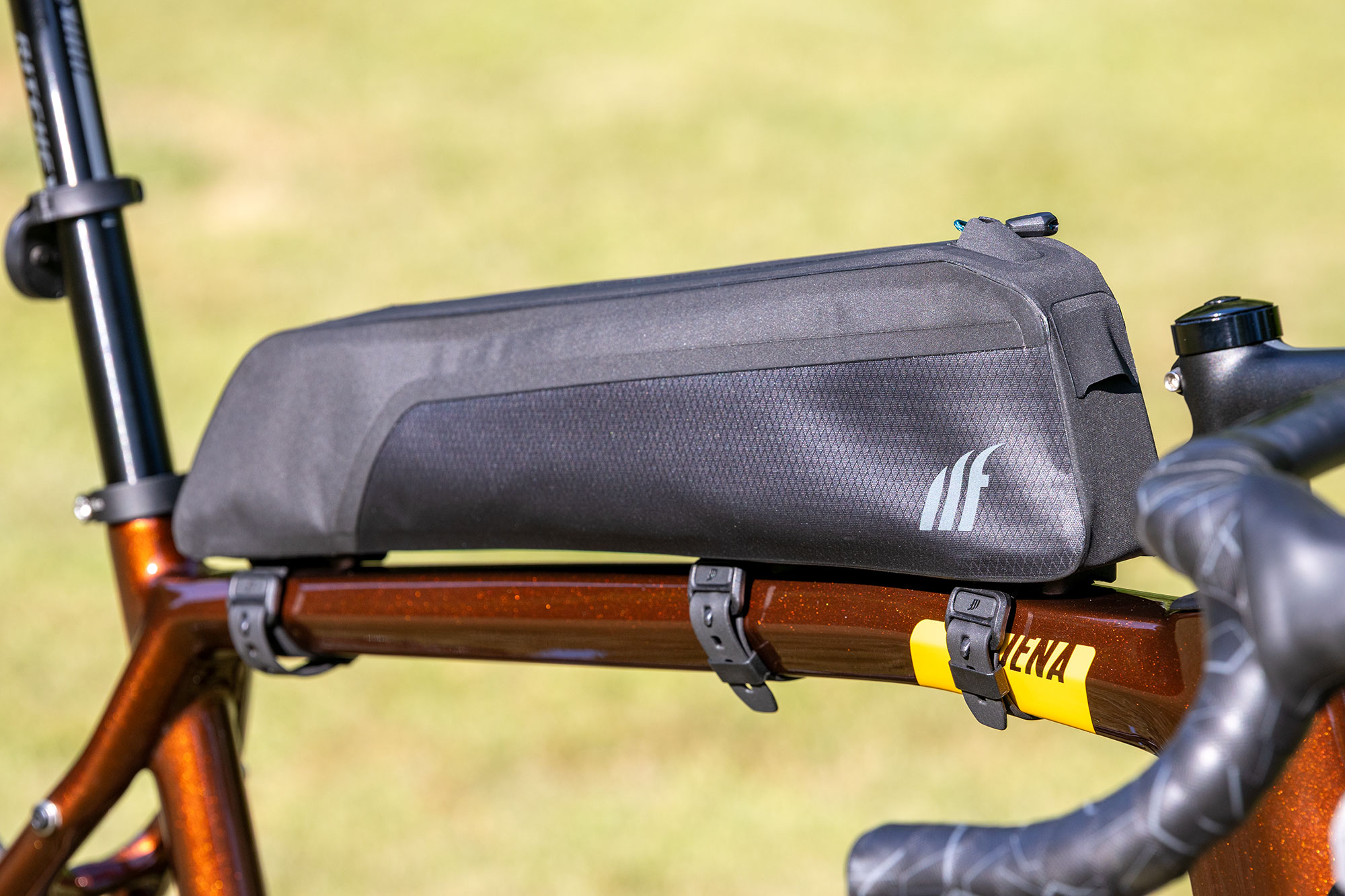
The bag is pretty rigid, yet there's just enough flex for it to conform to my Jena's kinked top tube.
Tailfin's Long Top Tube Bag is available in three sizes: 1.6 litres, 2.2 litres, and 3.0 litres. Total length is 370mm, 470mm, and 500mm, respectively, making them all substantially longer and more capacious than the brand's largest regular top tube bag, which has a volume of 1.5 litres and a length of 272mm.
As one would expect, these larger bags significantly draw on the design and construction of their petite siblings, a range launched by Tailfin back in 2023. The smaller bags are available in both zip and flip-top versions, but for obvious reasons, the long bags come with a zip closure only. I was provided with a 2.2 litre sample for this review.
Tailfin favours a combination of Hypalon and diamond-patterned ripstop nylon for its high-frequency-welded bags, a blend that provides a healthy balance of weather resistance, durability, and non-abrasiveness. It describes the long, double-entry zip, which runs nearly the entire length of the bag, as 'highly water resistant', adding that the bag as a whole is 'functionally waterproof'.
Zips will always represent a potential weak point, primarily due to human error - namely, forgetting to fasten them securely
In reality, zips will always represent a potential weak point, primarily due to human error, namely, forgetting to fasten them securely. As long as the slider is pulled snugly home and the bag is not overloaded, the zip should maintain an excellent seal.
However, Tailfin does recommend placing valuable electronic gear and the like in a secondary waterproof bag, just in case. To the brand's credit, in an attempt to make this bag as waterproof as possible, it has developed a unique 'rain gutter' channel to drain excess water away from the rear zip end stop. The cable port at the front of the bag is also well-protected, with a shroud that's deep enough to shield it from a deluge of rain and road spray.
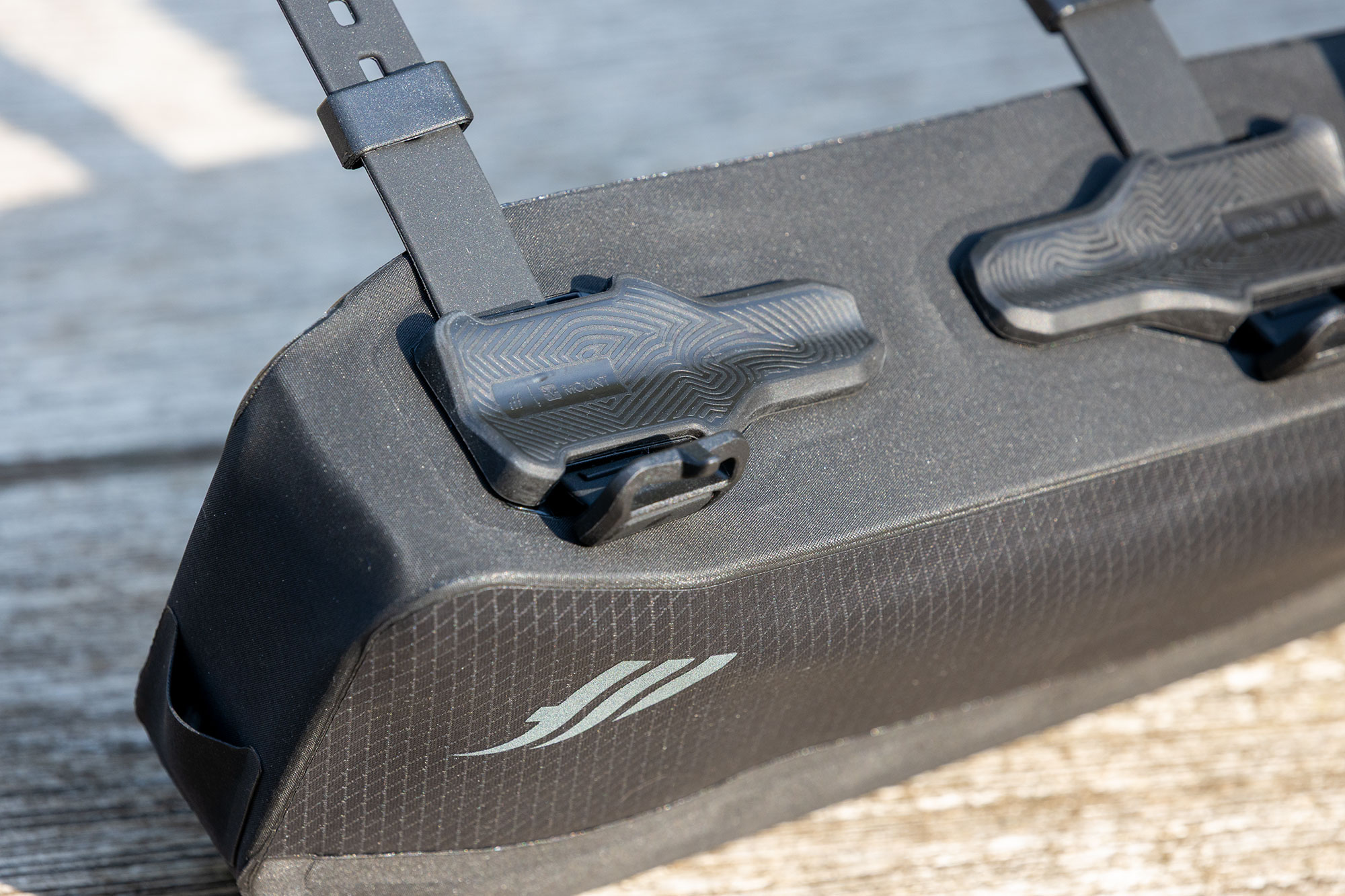
Tailfin's V-mount system is both fast to use and rock solid.
Tailfin is particularly proud of the V-mount system it uses to attach its frame bags, downtube packs and top tube bags. For these long bags, three sizeable, V-profiled aluminium feet are permanently affixed to the base, each with a slot for a TPU cargo strap (similar to a Voile ski tie) and wearing a rubberised foot.
Tailfin includes four straps with the bag, three 190mm straps, and a single, longer 470mm strap for use on smaller frames where the ends of the top tube and downtube are conjoined in a bulky junction.
Mounting is simply a matter of placing the feet on your bike's top tube, threading the straps and fastening. If you're also rocking a Tailfin frame bag, the feet on both products align, allowing you to use a single set of straps. The two forward feet are also pre-drilled for standard top-tube bolts, so if your frame has the mounts, you can choose to go strapless.
Tailfin says the V-shaped profile of the feet will conform to any tube shape – round, flat, oval, etc – and that the system is so secure, there's no requirement for a stem strap. It also promises that your bike will remain scratch-free, thanks to the rock-solid rubber feet, which prevent rubbing.
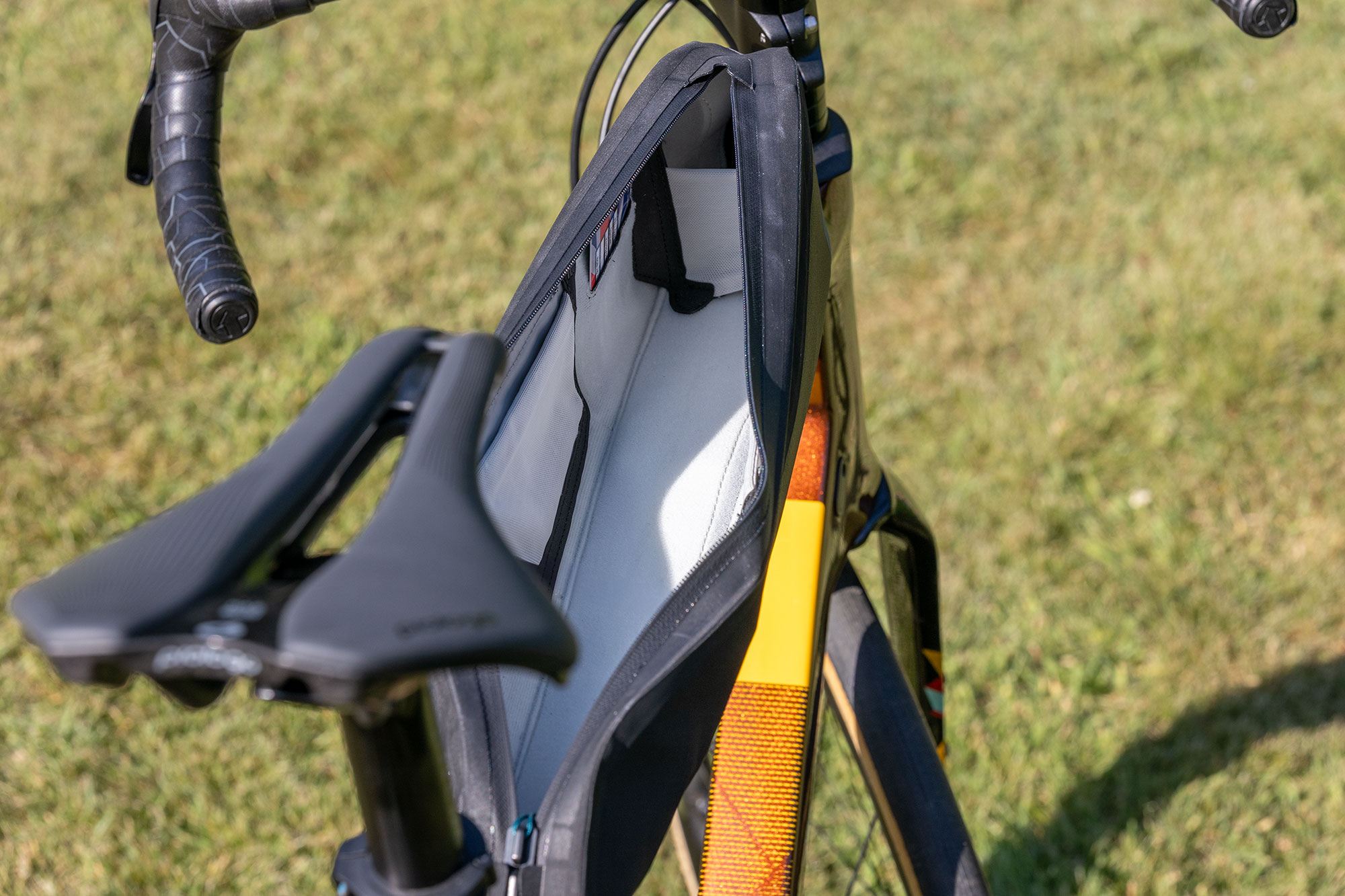
The plush inner liner can be organised with dividers and accessory pockets. The bag had to be propped wide open to take this shot.
Internally, the bag features a soft, plush inner liner with a padded base, reinforced along the sides with a nylon exoskeleton and carbon rods. These provide ample structure to prevent the bag from leaning or bulging, thereby avoiding knee rub and reducing the stress exerted on the zip.
Only one internal divider is included, which seems mean-spirited. Considering the cost of these bags, I believe Tailfin should include the optional Accessory Pack for free rather than charging an exorbitant £20 for a few small pieces of fabric.
It includes an additional divider, two accessory pockets, and two elasticated loops for securing tools. All are positioned with hook and loop fasteners, enabling you to segment the interior as needed.
On a more positive note, the bag is beautifully made, with impeccable welding and neat stitching throughout. It feels durable enough to last many seasons, partly due to its 'real-world' weight of 340g (including three straps and accessory pack dividers/pockets).
The reflective Tailfin logo on each flank is an elegant touch
The Ride
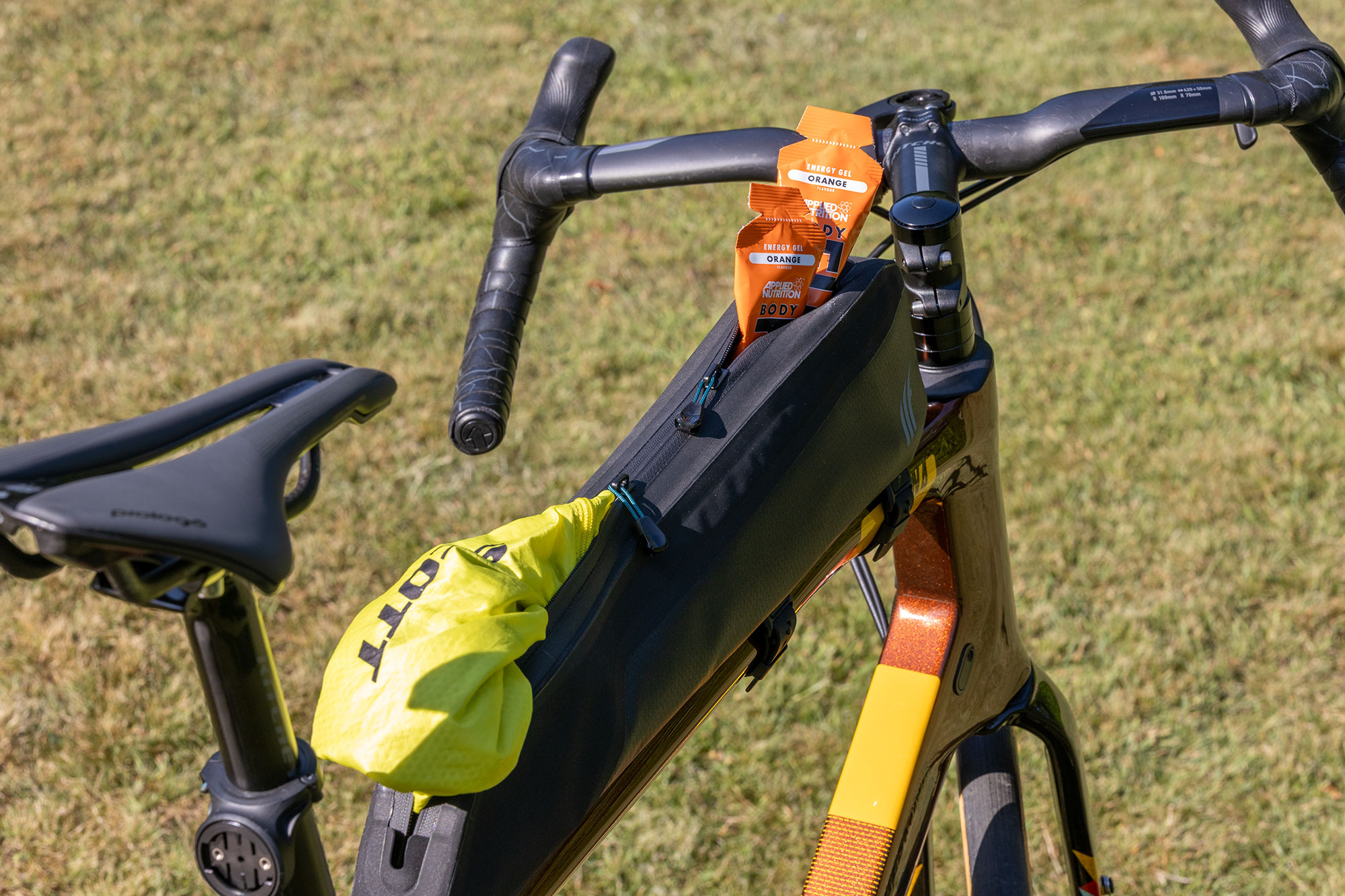
The dual zipper can be operated with just one hand, making it easy to retrieve items from the front or the rear of the bag.
Why consider adding a long top tube bag to your bikepacking setup? On the face of it, these bags are potentially less stable than a frame bag, and they raise your bike's centre of gravity. Standover height can also be compromised.
A greater concern is the opportunity they provide for stowing gear you'll probably never need – in my experience, bikepacking gear will invariably expand to fill any available space!
On the plus side, their central placement makes them less likely to impair bike handling in the way that bar bags, seat bags, and panniers can. A long top tube bag can also prove essential for cyclists riding smaller frame sizes, as the main triangle may be too small to accommodate a frame bag.
There’s plenty of room for wet-weather gear, warm layers, a spare pair of riding glasses...
Like standard top tube bags, they provide an excellent space for storing items you might need quickly during a ride. However, the extra capacity means you're no longer restricted to just a few snacks, your phone, and a multitool. There's plenty of room for wet-weather gear, warm layers, a spare pair of riding glasses with lighter lenses, and so forth.
Finally, with the massive rise in the popularity of bike-related content creation and vlogging, long top tube bags offer a very convenient place to stow spare batteries, leads, memory cards, and even lenses. So, despite initially being a long top tube bag sceptic, I'm now won over. Although I'm no longer riding with bare minimal kit, I am arguably more comfortable between ride legs, making me more inclined to bikepack more often.
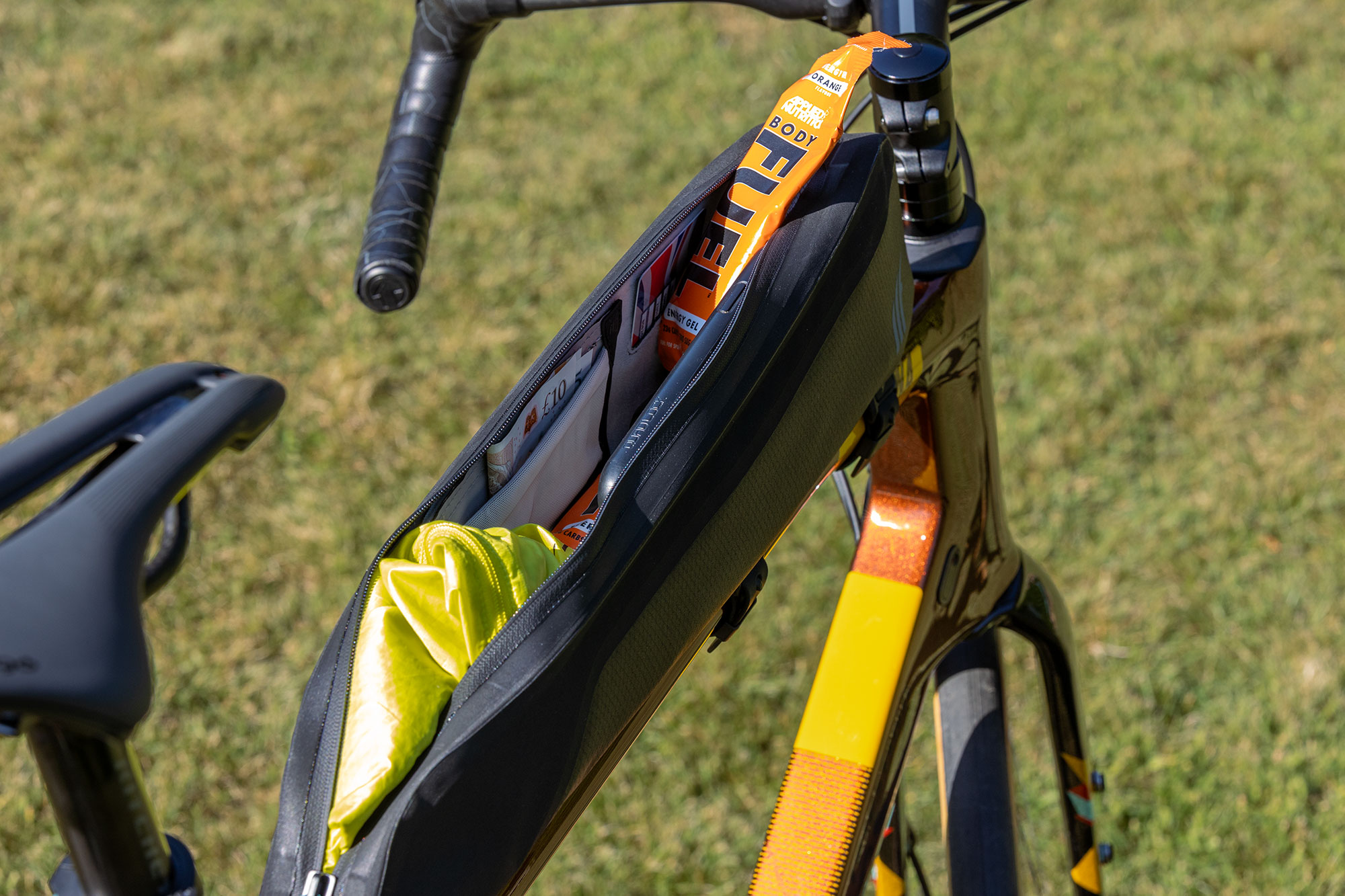
It's a handy place to stow items you may need in a hurry, such as gels, waterproofs, phones, cash and so on.
I chose my Wilier Jena as a test rig for this review. It’s a bike built for fast gravel, but its numerous frame and fork mounts make it a worthy choice for bikepacking.
Somewhat unusually, the top tube is kinked a few inches before it meets the head tube, which improves stand-over clearance. Worried that this would make mounting the Tailfin bag problematic, I was pleased to find that there is just enough flex in the bag's base and reinforced sidewalls for it to conform to the Jena's frame. If anything, this frame design quirk works in my favour, reducing the jeopardy of grounding out on the bag's long zipper.
As described previously, mounting the bag is a breeze. Its length makes it a little more unwieldy than regular-sized bags, but nevertheless, I found the whole process takes less than a minute.
True to Tailfin's claims, I found the bag remained impressively planted over all kinds of road surfaces and some light gravel. So far, my Jena's top tube is holding up well too, with no signs of wear and tear.

The cable port is heavily shrouded to keep water out. Note the reflective logo on the flank.
Frame bags and large top tube bags get a bad rap for causing knee and thigh rub, a reputation that's largely undeserved – overpacking is usually the culprit.
Both the 1.6 litre and 2.2 litre bags are quite narrow, measuring 65mm at the nose, tapering down to a very slender 39mm at the tail. The svelte dimensions of my bag, combined with the reinforced sides that all but eliminate bulging, meant that I was never even close to coming into contact with the bag.
The 3 litre bag is considerably wider at 85mm max width, which is why Tailfin only recommends it for MTBs, as they tend to have a much wider Q Factor.
Beyond preserving the bag's structure, the reinforced sides ensure that the zip remains perfectly aligned at all times, making it a pleasure to open and close with one hand, even while on the move. Having battled in vain with the zips on other similar bags, I found this to be a significant benefit, enough to sway me towards recommending this bag over much of the competition. Kudos to Tailfin.
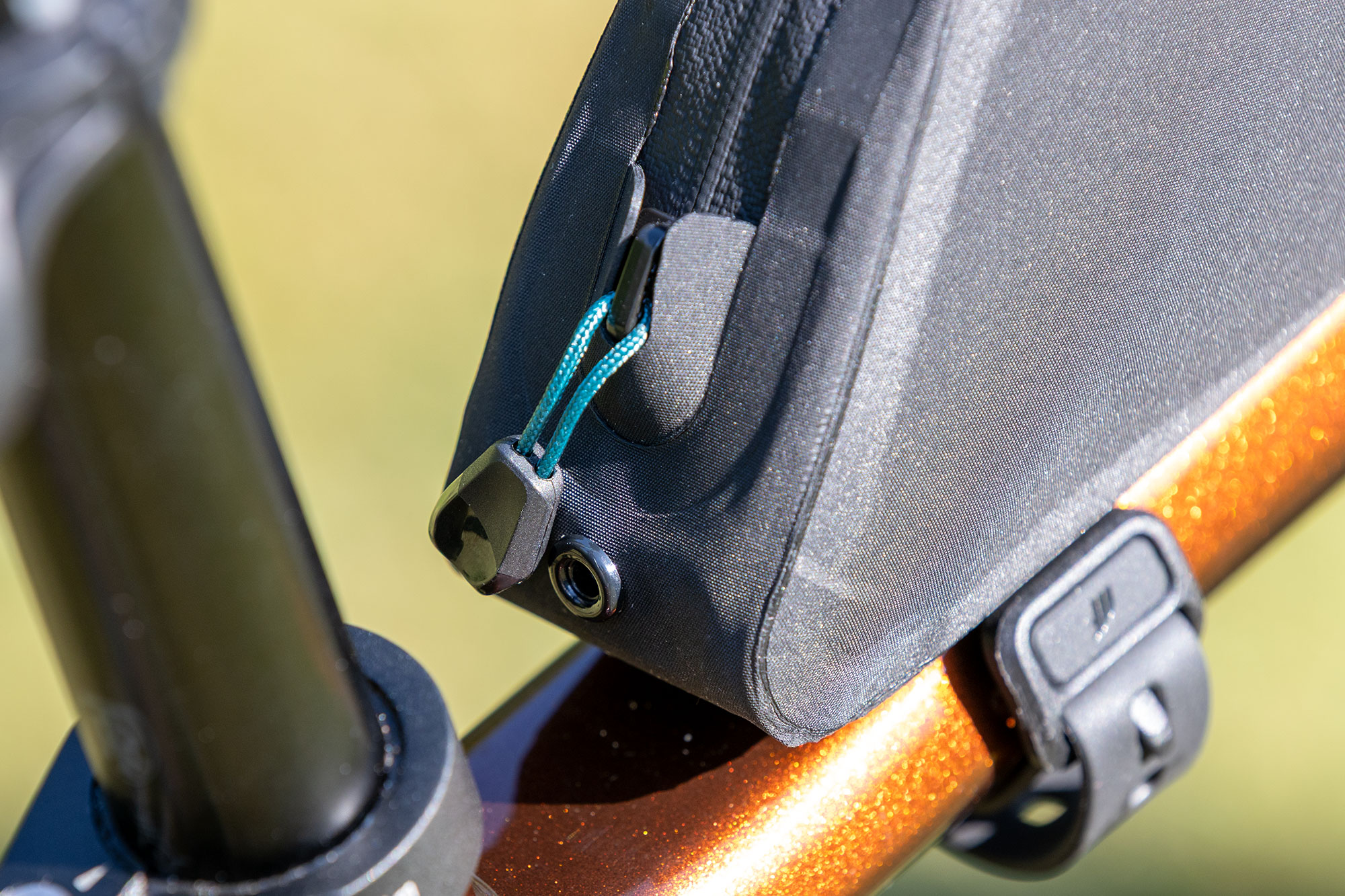
Tailfin has developed a unique 'rain gutter' for this bag. Any water that begins to collect in the zip garage will flow down and out through the drainage hole that sits just beneath it.
On the downside, this rigidity encourages the bag to remain closed even when the zipper is fully open, making it pretty hard to peer inside the bag unless you part the sides with both hands.
A quick fumble in the dark is as good as I could hope for while riding, which is why I believe the Accessory Pack is a must. Organising the contents of this bag pays dividends if you need to find specific items in a hurry.
I've been using a Tailfin AeroPack for a couple of years now, in all kinds of weather. I've never had problems with rain or spray entering the bag, so I'm pretty confident that Tailfin's weather-resistant zips do a fine job of keeping water out.
So far, so good with the Long Top Tube Bag too. We've had an unseasonably dry spring here in the Cotswolds, but the bag shrugged off the showers that I have ridden through, some quite heavy. I've also hosed the bag down on a couple of occasions, and it's experienced zero water ingress.
Value and conclusions
At £100 / $120, plus a further £20/ $20 for the accessory pack, which I believe is a must-have, the 2.2 litre Tailfin Top Tube Bag is quite the investment. If you don't need the capacity, the 1.6-litre model will save you £ 15/$5. If you run an MTB, the 3.0-litre version will cost you an additional £ 15/$5.
But ask yourself this: Do you need a long top tube bag? I'm convinced that many riders are better off with a regular top tube bag for snacks and so on, while using other bags elsewhere on the bike to stow the majority of their kit. Tailfin makes an excellent 1.1 litre zipped top tube bag for just £55/ $85.
However, for those with smaller frames or a genuine need to carry additional gear that needs to be accessed quickly, a larger top tube bag is a sensible purchase. Tailfin's version overcomes many of the obvious drawbacks. It is ultra-stable, unshakably secure, and easy to open with one hand while pedalling. It's also durable, beautifully made and convincingly weatherproof.
Alternatives include the 2 litre Apidura Racing Long Top Tube Pack, which at £74 / $136 and 200g is both lighter on the pocket and on the bike. The spec is similar to the Tailfin bag, but it lacks the reinforced sides.
Restrap's 2.0 litre Race Top Tube Bag – Long does have a reinforced inner to ensure structural integrity. It also comes with handy mesh side pockets for storing used gel packets and other ride detritus. At £74.99/ $104, it is priced similarly to the Apidura bag.
The prices of both these bags make the Tailfin seem expensive for what it is; however, neither features its impressively secure mounting system, instead relying on more conventional hook-and-loop or fabric buckle straps. Additionally, if you've already invested in a Tailfin frame bag, being able to utilise the same straps is a neat solution. Lastly, if you're a devotee of the Tailfin ecosystem, you'll probably want to remain loyal to the brand for the sake of appearance, if nothing else.
Specs
- Available sizes: 1.6-litre, 2.2-litre (reviewed) and 3.0-litre
- Max width: 65mm for the smaller bags. 85mm for the 3.0l (recommended for MTBs only)
- Fabrics: 210D Hypalon & 210D Diamond RipStop
- Zipper: Dual entry, weather resistant
- Inner: Plush fabric liner with cushioned base. Sides reinforced with nylon shell and carbon rods.
- Waterproof: Tailfin claims the bag to be ‘functionally waterproof’.
- Weight (2.2-litre, as reviewed): 340g

Thank you for reading 20 articles this month* Join now for unlimited access
Enjoy your first month for just £1 / $1 / €1
*Read 5 free articles per month without a subscription

Join now for unlimited access
Try first month for just £1 / $1 / €1
The latest race content, interviews, features, reviews and expert buying guides, direct to your inbox!

Simon spent his childhood living just a stone’s throw from the foot of Box Hill, so it’s no surprise he acquired a passion for cycling from an early age. He’s still drawn to hilly places, having cycled, climbed or skied his way across the Alps, Pyrenees, Andes, Atlas Mountains and the Watkins range in the Arctic.
Simon now writes for Cycling Weekly as a freelancer, having previously served as Tech Editor. He’s also an advanced (RYT 500) yoga teacher, which further fuels his fascination for the relationship between performance and recovery.
He lives with Jo, his yoga teacher wife, in the heart of the Cotswolds, with two rescue cats, five bikes and way too many yoga mats. He still believes he could have been a contender if only chocolate weren’t so moreish.
You must confirm your public display name before commenting
Please logout and then login again, you will then be prompted to enter your display name.